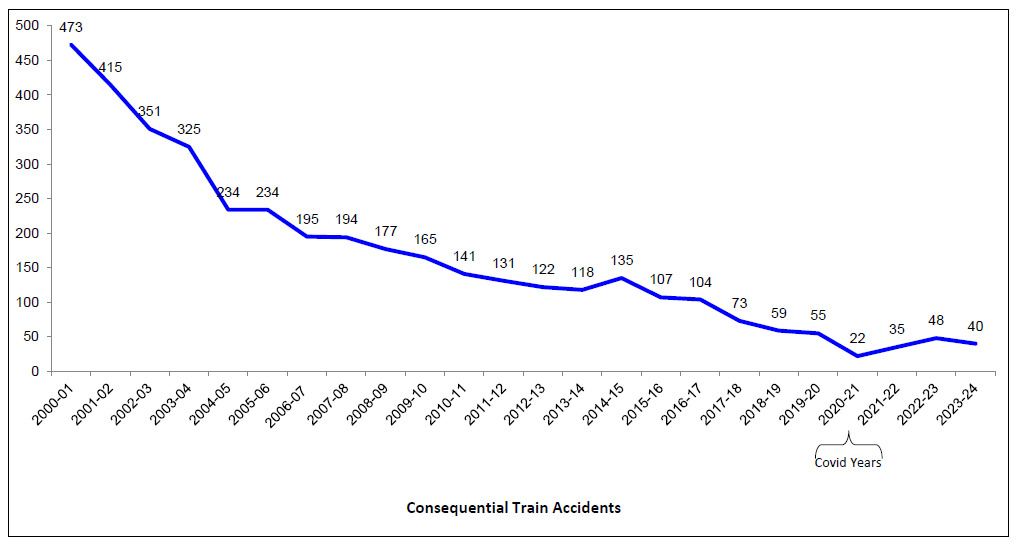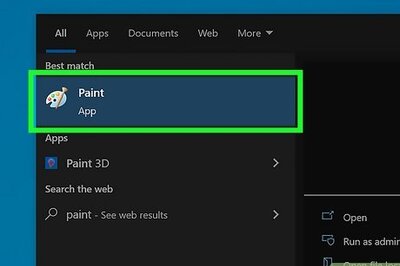68 Train Accidents A Year From 2014-24 As Against 171 During 2004-2014: Govt Data On Safety Measures

views
Even as the investigation into the cause of Monday’s Kanchanjunga Express mishap is on, data shows that safety measures taken by the government have brought down the number of consequential train accidents to 68 per annum (2014-2024), compared to 171 per annum (2004-2014).
At least 10 people died and more than 40 injured as a goods train hit the 13174 Kanchanjunga Express, which was bound for Sealdah from Agartala, in Siliguri’s Rangapani region around 9 am. The accident happened seven km from North Bengal’s New Jalpaiguri station, soon after the express train left the New Jalpaiguri station. The driver and assistant driver of the goods train and guard of the express train died in the incident. The cause is still unclear as the probe has revealed that the goods train driver was allowed to pass all red lights as the automatic signalling system was defective, while the railways claimed he allegedly violated the distance protocol.
India has the fourth-largest railway system in the world, following the US, Russia and China. In the past few years, several steps have been taken up by Indian railways to develop railway infrastructure, modernise the system and improve operational efficiency and safety.
According to the government data, the number of consequential train accidents per annum was 473 in 2000-01, 415 in 2001-02, 351 in 2002-03, 325 in 2003-04, 234 in 2004-05 and 2005-06, 195 in 2006-07, 194 in 2007-08, 177 in 2008-09, 165 in 2009-10, 141 in 2010-11, 131 in 2011-12, 132 in 2012-13 and 118 in 2013-14. The number stood at 135 in 2014-15, 107 in 2015-16, 104 in 2016-17, 73 in 2017-18, 59 in 2018-19, 55 in 2019-20. In the Covid years of 2020-21, the number was 22 and 35 in 2021-22. In 2022-23, the number was 48 and 40 in 2023-24.

SAFETY PERFORMANCE: 2004-14 vs 2014-24
- Expenditure on safety-related works increased 2.5 times, from Rs 70,273 crore in 2004-14, to Rs 1.78 lakh crore during 2014-24.
- Track renewal expenditure increased 2.33 times, from Rs 47,018 crore in 2004-14 to Rs. 1,09,659 crore during 2014-24.
- Weld failures reduced 87%, from 3,699 in 2013-14 to 481 in 2023-24.
- Rail fractures reduced 85%, from 2,548 in 2013-14 to 383 in 2023-24.
- Expenditure on level crossing (LC) Elimination increased 6.4 times, from Rs 5,726 crore 2004-14, to Rs 36,699 crore during 2014-24.
- Unmanned level crossing gates reduced 100%, from 8,948 as on 31.03.2014 to 0 by 31.01.19.
- Construction of road over bridges increased 2.9 times, from 4,148 during 2004-14 to 11,945 during 2014-24.
- Expenditure on bridge rehabilitation increased 2 times, from Rs. 3,919 crore during 2004-14 to Rs. 8,008 crore during 2014-24.
- Electronic interlocking (stations) increased 3.5 times, from 837 during 2004-14 to 2,964 during 2014-24.
- Automatic block signaling increased 1.67 times from 1,486 km during 2004-14 to 2,497 km during 2014-24.
- Fog pass safety devices increased 219 times, from 90 as on 31.03.14 to 19,742 as on 31.03.24.
- Manufacturing of LHB coaches increased 15.8 times, from 2,337 during 2004-14 to 36,933 during 2014-24.
- Provision of fire and smoke detection system in AC coaches increased from 0 in 2014 to 19,271 in 2024.
- Provision of fire extinguishers in Non-AC coaches increased from 0 in 2014 to 66,840 in 2024.
MEASURES TO BOOST SAFETY
Rashtriya Rail Sanraksha Kosh (RRSK) was introduced in 2017-18 with a corpus of Rs 1 lakh crore for five years, for replacement, renewal and upgradation of critical safety assets. From 2017-18 to 2021-22, a gross expenditure of Rs 1.08 lakh crore was incurred on RRSK work. In 2022-23, the government extended RRSK for another five years with a Gross Budgetary Support (GBS) of Rs 45,000 crore.
KAVACH system has been adopted as the National Automatic Train Protection (ATP) system. This system aids the loco pilot by automatically applying brakes if the pilot fails to do so, ensuring safe train operations even in bad weather. So far, KAVACH had been implemented on 1,465 Rkm and 121 locomotives.
To further enhance safety, 6,586 stations had been provided with electronic interlocking (EI) by May 31, 2024. Additionally, automatic block signalling (ABS) was implemented on 4,111 RKm of High-Density Routes by Oct 31, 2023. Safety at level crossing gates was addressed by interlocking 11,137 gates with signals by Oct 31, 2023. All unmanned level crossings on Broad Gauge routes were eliminated by Jan 2019.
All locomotives are now equipped with vigilance control devices (VCD) to ensure the alertness of loco pilots, and GPS-based Fog Safety Devices (FSD) have been provided to pilots in fog-affected areas.
For track safety, the maintenance has been revolutionized by introducing advanced track recording cars, which are faster and more reliable. Complete track circuiting has been provided at 6,609 stations by May 31, 2023. To verify track safety, ultrasonic testing of rails is conducted to detect flaws.
In terms of bridge safety, a bridge management system (BMS), a web-based IT application, has been developed to provide 24×7 access to bridge information. New technologies for bridge inspection, such as continuous water level monitoring, drone inspections, and 3D scanning of riverbeds, have been introduced.
To improve the safety of rolling stock, advanced technologies like the Online Monitoring of Rolling Stock System (OMRS) and Wheel Impact Load Detector (WILD) have been adopted for predictive maintenance. Radio Frequency Identification (RFID) tags are being fitted to rolling stock for automatic tracking.
The replacement of conventional ICF design coaches with LHB design coaches is ongoing.




















Comments
0 comment